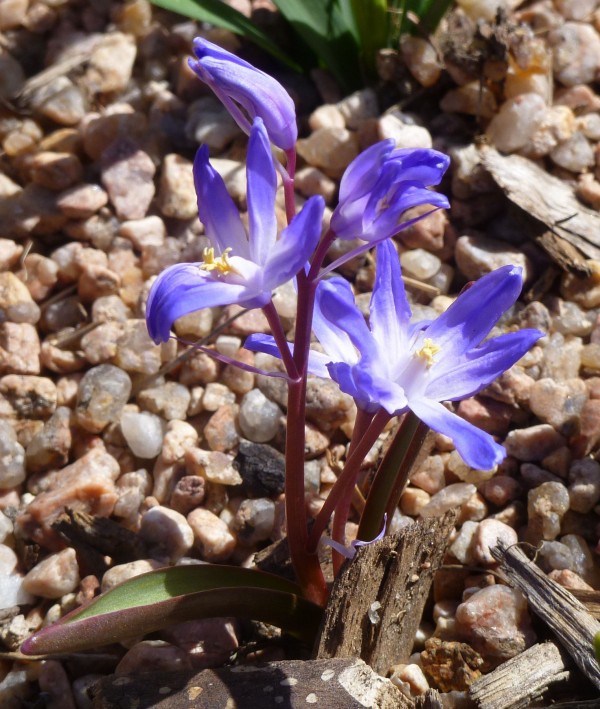
| Quick Facts | |
|---|---|
| Plant Family: | Hyacinthaceae (Hyacinth) |
| Plant Type: | Bulb |
| Garden: | Children's, Xeriscape |
| USDA Hardiness Zone: | 3 |
| Size (height x width): | 4" - 6" x 2" - 4" |
| Bloom Time: | March, April |
| Bloom Color: | Pink, Purple, White |
| Light Needs: | Full Sun, Partial Shade |
| Deer Resistant: | Yes |
| More information for Lucile’s glory of the snow | |
Description:
Very early spring blooming low growing perennial from bulbs. The sword shaped leaves are mid-green on top and reddish brown underneath which matches the color of the stem. Each stem will bear one to 4 star-like upward facing flowers in either white, violet-blue or pink and have white centers. This bulb will spread by bulb offsets and self seeding.
Landscape Use:
Rock garden, Under deciduous trees, Mass planting
Culture:
Plant bulbs in the fall. Site so plant is in full sun when blooming. Some water during dormancy. Leave bulbs undisturbed except for division, as desired, every 4-5 years.
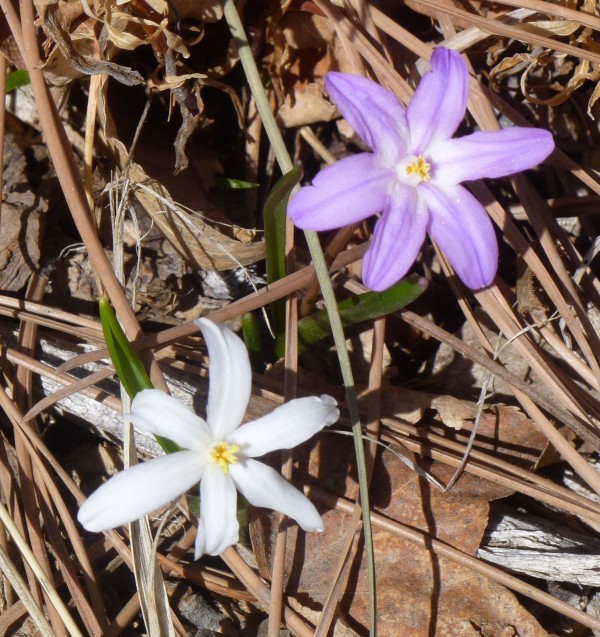
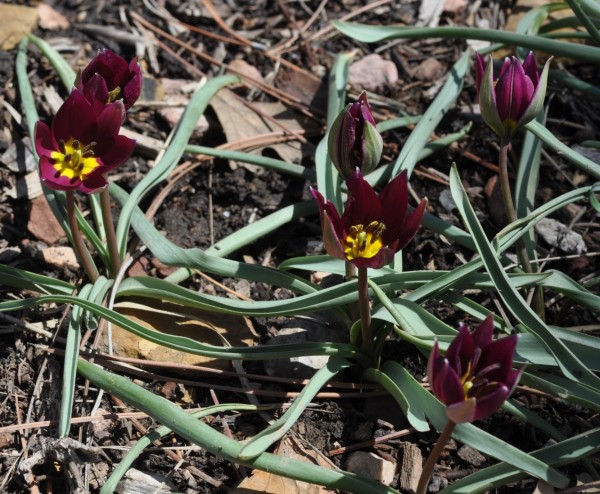
| Quick Facts | |
|---|---|
| Plant Family: | Liliaceae (Lily) |
| Plant Type: | Bulb |
| Garden: | Children's |
| USDA Hardiness Zone: | 3 |
| Size (height x width): | 4" - 6" x 2" - 4" |
| Bloom Time: | March, April |
| Bloom Color: | Pink |
| Light Needs: | Full Sun, Partial Shade |
| Xeric (less water once established): | Yes |
| Deer Resistant: | Yes |
| More information for Persian Pearl tulip | |
Description:
Tulips are classified into 15 groups Persian Pearl tulip is a species tulip, Miscellaneous group, humilis species. Each bulb of the Miscellaneous group has 2-5 linear, channeled, gray-green leaves to 6 inches long. The dark magenta colored flowers are star shaped wide with a bright yellow center. This bulb will naturalize (spread).
Landscape Use:
Borders, Rock gardens, Mass Plantings
Culture:
Plant this bulb in the fall in well-drained soil. Species tulips prefer dry conditions when dormant. Deadhead and apply a balanced fertilizer after flowering but allow the foliage to yellow before removing.
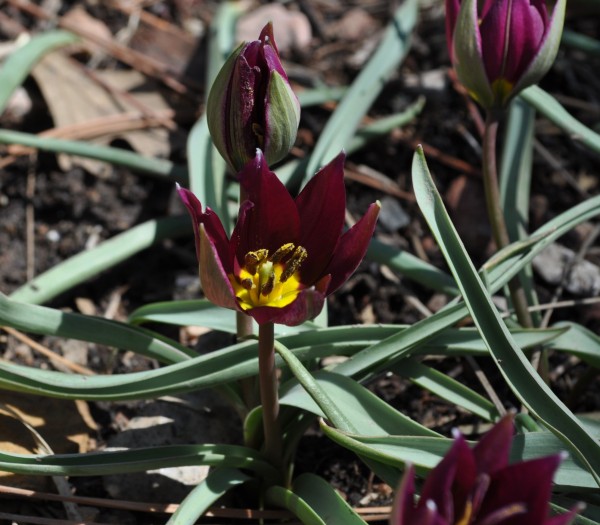
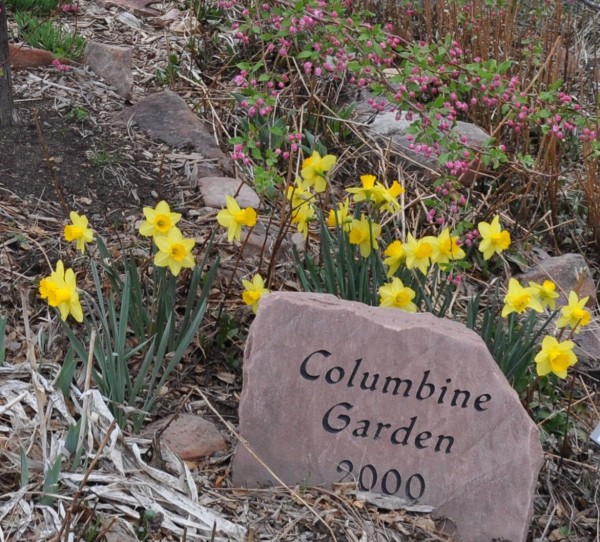
| Quick Facts | |
|---|---|
| Plant Family: | Amaryllidaceae (Amaryllis) |
| Plant Type: | Bulb |
| Garden: | Columbine |
| USDA Hardiness Zone: | 3 |
| Size (height x width): | 16" - 18" x 6"-8" |
| Bloom Time: | April |
| Bloom Color: | Yellow |
| Light Needs: | Full Sun, Partial Shade |
| Deer Resistant: | Yes |
| Rabbit Resistant: | Yes |
| More information for Spellbinder daffodil | |
Description:
Daffodils are split into 13 divisions. Spellbinder is in Division 1, Trumpet daffodils and flowers early to mid-spring. The cup (corona) is described as a trumpet and is as long or longer than the petals (perianth) segments. The flowers are greenish yellow and the trumpet gradually fades to white with whitish green at the mouth.
Landscape Use:
Borders, Under deciduous trees, In front of shrubs, Mass plantings
Culture:
Plant bulbs in the fall in well-drained moderately fertile soil that is kept moist during the growing season. After flowering, remove spent blossoms but keep leaves until they yellow. Apply a low nitrogen, high potash fertilizer after flowering if bulbs are not blooming well. Daffodil can naturalize (spread).
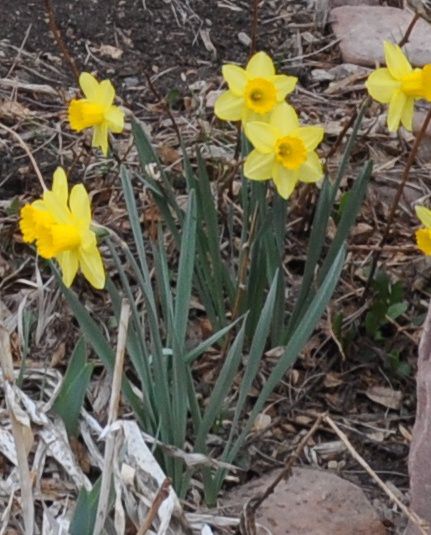
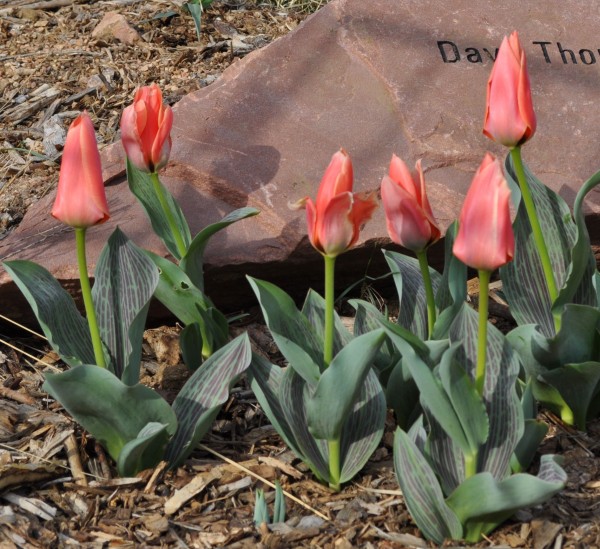
| Quick Facts | |
|---|---|
| Plant Family: | Liliaceae (Lily) |
| Plant Type: | Bulb |
| Garden: | Metal Arch |
| USDA Hardiness Zone: | 3 |
| Size (height x width): | 10" x 6" |
| Bloom Time: | April |
| Bloom Color: | Orange |
| Light Needs: | Full Sun |
| Xeric (less water once established): | Yes |
| More information for Calypso tulip | |
Description:
Tulips are classified into 15 groups Calypso tulip is a species tulip, Greigii group. Each bulb of the greigii group has 2-7 wide, lance shaped, grey green leaves with reddish or dark purple stripes. Calypso has large coral/apricot colored blooms. This bulb will naturalize (spread).
Landscape Use:
Borders, Rock garden, Mass plantings
Culture:
Plant this bulb in the fall in well-drained soil. Species tulips prefer dry conditions when dormant. Deadhead and apply a balanced fertilizer after flowering but allow the foliage to yellow before removing.


| Quick Facts | |
|---|---|
| Plant Family: | Ranunculaceae (Buttercup) |
| Plant Type: | Herbaceous perennial |
| Garden: | Children's |
| USDA Hardiness Zone: | 3 |
| Size (height x width): | 2' - 3' x 1' to 1.5' |
| Bloom Time: | June |
| Bloom Color: | Red |
| Light Needs: | Full Sun, Partial Shade |
| Deer Resistant: | Yes |
| Rabbit Resistant: | Yes |
| Attracts Hummingbirds: | Yes |
| Native: | Yes |
| More information for Canada columbine | |
Description:
This Columbine is native to eastern North America. It has a nodding flower head with orangish-red and yellow flowers and bushy yellow stamens. Other common names are Wild Columbine and American Columbine.
Landscape Use:
Woodland garden, Native plant garden, Border
Culture:
Prefers well drained, rich, moist soils in light to moderate shade. Will self seed and naturalize when growing in optimum conditions. Deadhead after bloom for quick reflush.
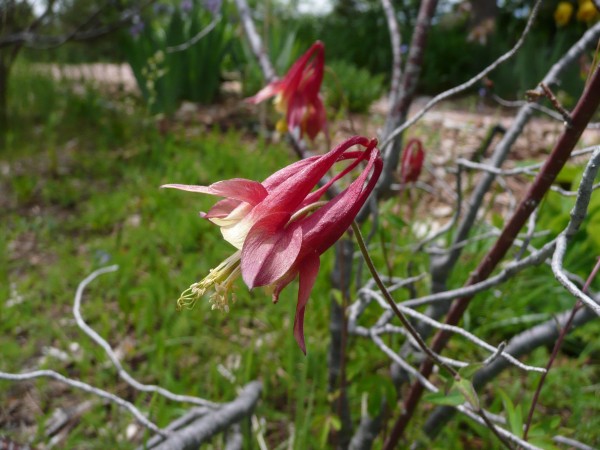
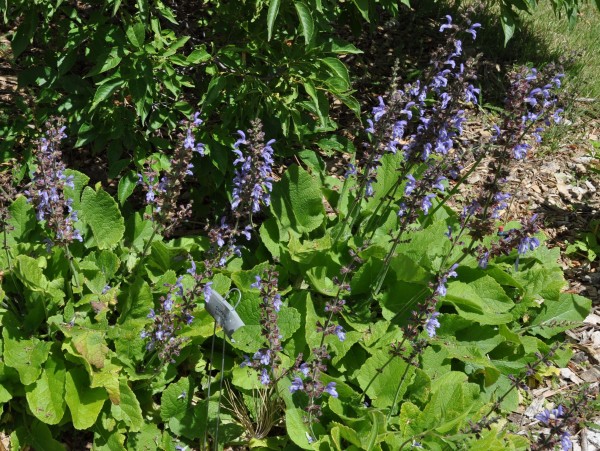
| Quick Facts | |
|---|---|
| Plant Family: | Lamiaceae (Mint) |
| Plant Type: | Herbaceous perennial |
| Garden: | Children's |
| USDA Hardiness Zone: | 4 |
| Size (height x width): | 3' x 1' |
| Bloom Time: | July, August, September, October |
| Bloom Color: | Purple |
| Light Needs: | Full Sun |
| Deer Resistant: | Yes |
| Rabbit Resistant: | Yes |
| Attracts Bees & Butterflies: | Yes |
Description:
Clary sage is a biennial (often lives longer than 2 years and spreads through seeding new plants). Honeybees love Clary sage. The purple blooms are held on 3′ stalks that rise above the basal rosette of leaves. The leaves are very strong scented and some people say it creates a scent hedge to deter rabbits.
Landscape Use:
Herb garden, Back border, Pollinator garden
Culture:
Prefers well-drained soil. Deadhead to limit the spread.

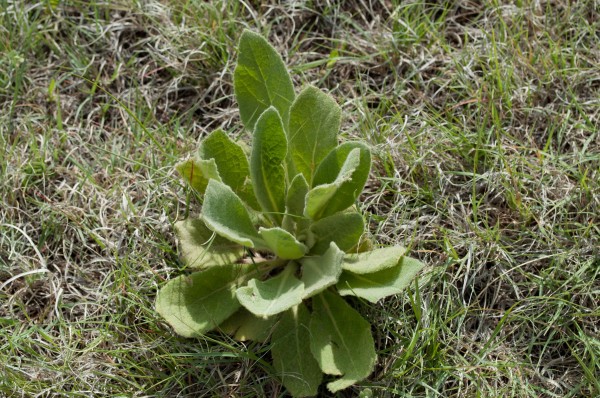
| Quick Facts | |
|---|---|
| Plant Family: | Scrophulariaceae (Figwort) |
| Plant Type: | Weed |
| Garden: | Outlying |
| USDA Hardiness Zone: | 3 |
| Size (height x width): | 2' - 5' x 2' |
| Bloom Time: | June, July, August |
| Bloom Color: | Yellow |
| Light Needs: | Full Sun |
| More information for Common mullein | |
Description:
Common mullein is on the Colorado Noxious Weed List C and is found at elevations from 4,500 to 9,000 ft. on sunny, disturbed sites, including prairie dog colonies. It was first noted as a common weed in Boulder in 1905. It is a biennial. Rosettes of leaves covered with fine hairs are produced in the first year. The second year produces a single stout stem and wooly leaves and flowers. An adult mullein can produce 100,000 – 180,000 seeds. The seeds may last more than 80 years. List C plants are selected for control methods.
Landscape Use:
Colorado Weed Management Association definition of a noxious weed: "They are non-native plants that are disrupting our native vegetation and ecosystems. Noxious weeds threaten our drinking supply, agricultural crops, pasture lands and native habitats."
Culture:
This plant is native to Asia but was introduced to the U.S. by early European settlers. Once the soil of an area is disturbed, the seed has been known to germinate, even after it has been buried for a long time.
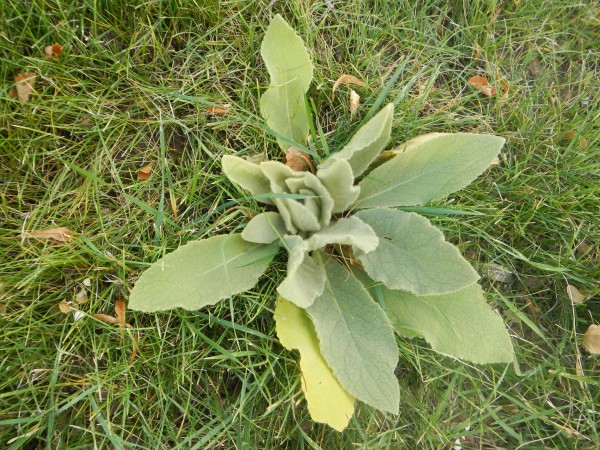
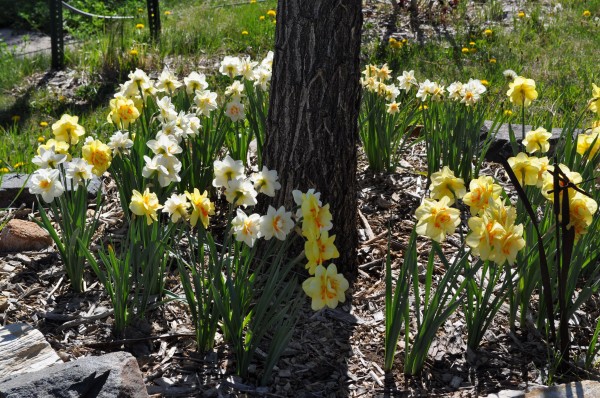
| Quick Facts | |
|---|---|
| Plant Family: | Amaryllidaceae (Amaryllis) |
| Plant Type: | Bulb |
| Garden: | Outlying |
| USDA Hardiness Zone: | 4 |
| Size (height x width): | 14" - 18" x 6 "- 8" |
| Bloom Time: | April |
| Bloom Color: | White, Yellow |
| Light Needs: | Full Sun, Partial Shade |
| Deer Resistant: | Yes |
| More information for Butterfly daffodil | |
Description:
Daffodils are split into 13 divisions. Butterfly daffodil is in Division 11b, Split Corona Papillon and blooms in Mid Spring, usually late April. The white and yellow flowers in this assortment have orange ruffled cups.
Landscape Use:
Between shrubs, Border, Near trees
Culture:
Plant bulbs in the fall in well-drained moderately fertile soil that is kept moist during the growing season. After flowering, remove spent blossoms but keep leaves until they yellow. Apply a low nitrogen, high potash fertilizer after flowering if bulbs are not blooming well. Daffodil can naturalize (spread).
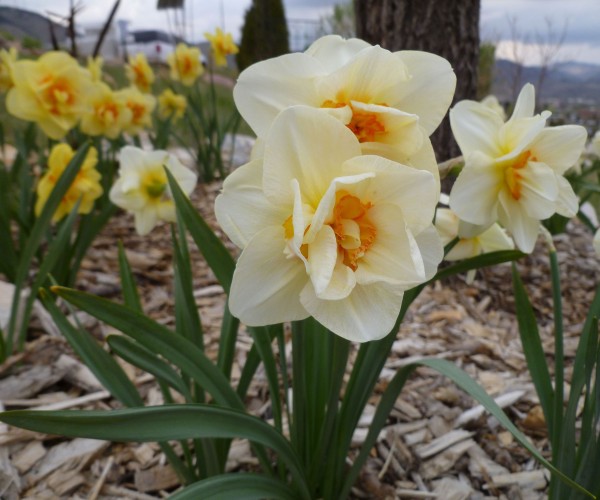

| Quick Facts | |
|---|---|
| Plant Family: | Rosaceae (Rose) |
| Plant Type: | Tree |
| Garden: | Outlying |
| USDA Hardiness Zone: | 4 |
| Size (height x width): | 25' - 15' |
| Bloom Time: | March, April |
| Bloom Color: | White |
| Light Needs: | Full Sun |
| More information for Chanticleer callery pear | |
Description:
Chanticleer callery pear is 1) an upright pyramidal shaped tree with low to medium water needs and a moderate growth rate, 2) has branch structure that is able to withstand ice and wind damage better than the Bradford pear and 3) can be snow-load damaged due to holding its leaves so late (into November). In spring, the tree is covered with 1″ white blossoms followed by olive colored pea-sized inedible fruits. The leaves turn a dark red-purple for beautiful fall color. This tree is recommended for planting along the Front Range area by a coalition of Colorado tree experts.
Landscape Use:
Shade tree, Specimen
Culture:
Plant in full sun, prune in winter or early spring. Chanticleer is fire-blight resistant and tolerates clay soils.

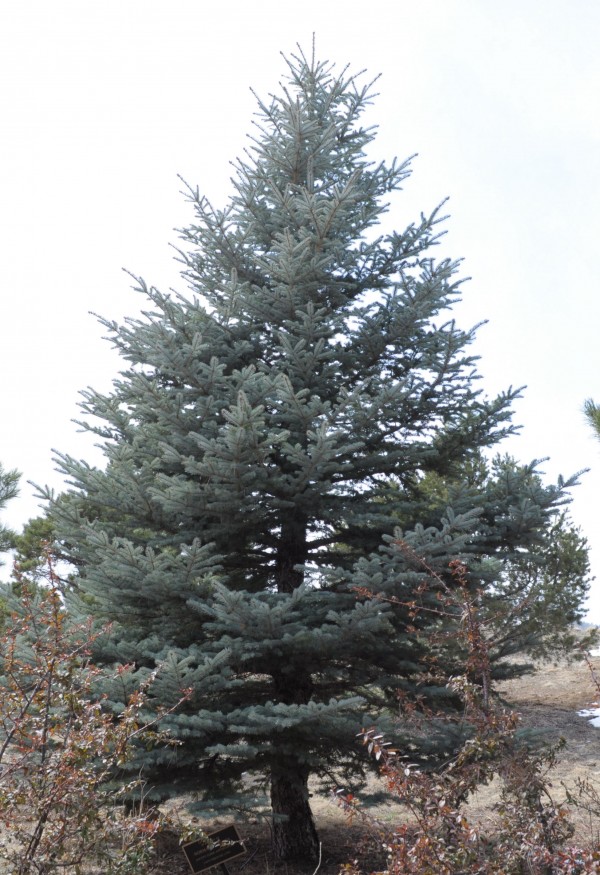
| Quick Facts | |
|---|---|
| Plant Family: | Pinaceae (Pine) |
| Plant Type: | Evergreen |
| Garden: | Outlying |
| USDA Hardiness Zone: | 3 |
| Size (height x width): | 60' x 25' |
| Bloom Time: | March, April, May |
| Bloom Color: | Does Not Flower |
| Light Needs: | Full Sun |
| Native: | Yes |
| More information for Colorado spruce | |
Description:
Colorado spruce, also called Colorado Blue Spruce is Colorado’s state tree. It was identified by botanist C.C. Parry on Pikes Peak in 1862. The native habitat is the Foothills and Montane life zone. The tree shape is pyramidal/spire-like, the short, sharp and stiff needles are green to blue-gray single and grow in a spiral pattern around the stem. The cones are golden brown, 2″-4″ long with papery scales and feel spongy when squeezed.
Landscape Use:
Specimen, Tall hedge, Screen
Culture:
It has a moderate growth rate and medium to high water needs. Planting altitude is 4,000 to 9,500 ft. Give this tree lots of room to grow.
